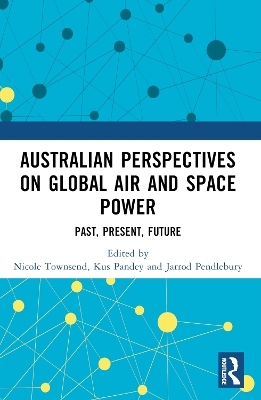
Australian Perspectives on Global Air and Space Power
Routledge (Verlag)
978-1-032-13739-1 (ISBN)
This book surveys historical and emerging global air and space power issues and provides a multidisciplinary understanding of the application of air and space power in the past and present, while exploring potential future challenges that global air forces may face.
Bringing together leading and emerging academics, professionals, and military personnel from Australia within the field of air and space power, this edited collection traces the evolution of technological innovations, as well as the ethical and cultural frameworks which have informed the development of air and space power in the 20th and 21st centuries, and contemplates the future. It covers topics such as the insurgents' use of drones, the ethics of air strikes, the privatisation of air power, the historical trajectory of air power strategy, and the sociological implications of an ‘air force’ identity. While many of the chapters use Australian-based case studies for their analysis, they have broader applicability to a global readership, and several chapters examine other nations’ experiences, including those of the United States and the United Kingdom.
This accessible, illuminating book is an important addition to contemporary air and space power literature, and will be of great interest to students and scholars of air and space power, air warfare, military and international history, defence studies, and contemporary strategic studies, as well as military professionals.
Nicole Townsend is currently completing a PhD in History at the University of New South Wales, Canberra. Her thesis focuses on Australia’s war in the Mediterranean during the Second World War, and she has both presented and published more broadly on the Second World War. She currently works as a researcher on the Official History of Australian Operations in Iraq and Afghanistan, based at the Australian War Memorial. Kus Pandey was the manager of the Australian Centre for the Study of Armed Conflict and Society (ACSACS) at the Australian Defence Force Academy campus of the University of New South Wales from 2018 to 2019. She was awarded an Australia Day Medallion by the Department of Defence for her contribution to ACSACS, with specific recognition of her support of the Sir James Rowland Seminars. Jarrod Pendlebury is an honorary research fellow with The King’s School Institute and a senior strategist in the Royal Australian Air Force. His research interests focus on the intersection of sociology and strategy, with particular emphasis on air power, and he has been published widely in Australia, Europe, and the United States.
Introduction: An Australian Perspective on Air and Space Power Part One: Historical Perspectives 1. Military Aviation in the British Dominions before the First World War 2. The Australian Prisoner of War Experience in Stalag Luft III, 1942–45 3. Sir James Rowland and the Changing Strategic Use of Air Power in Australia, 1942–1979 4. Australian Air Power Strategy, Technologies, and Counter-insurgency in Malaya during the Cold War Part Two: Identity and Culture 5. The Importance of Asking Why the Royal Australian Air Force Exists 6. Identity as a Gatekeeper in Western Air Forces 7. The RAAF and the Tyranny of Training Part Three: Technology and Air Power 8. Human, Organisational, and Technological Lessons from Air Power and Joint Operations in Major Conflict 9. The Privatisation of Air Power 10. Hypersonic Propulsion as an Air Power Disruption or Disturbance 11. Military Culture and Resistance to Technical Innovation 12. Rubbery Assumptions: Anti-G Suits and Air Power in the Second World War Part Four: Air and Space Power in the 21st Century 13. Ethics, Strategy, and Australian Air Power in the 21st Century 14. Manoeuvre in the 21st Century 15. An Overview of Australian Space Power, from Desert Rockets to New Beginnings Part Five: Future Directions 16. Can the ADF become the Most Uncrewed and Autonomy-enabled Defence Force in the World? 17. Space Power and the Vulnerabilities of Satellites 18. Considering the Effects of Disruptive Technologies on Air and Space Power 19. Conclusion
| Erscheinungsdatum | 13.03.2023 |
|---|---|
| Zusatzinfo | 2 Halftones, black and white; 2 Illustrations, black and white |
| Verlagsort | London |
| Sprache | englisch |
| Maße | 156 x 234 mm |
| Gewicht | 462 g |
| Themenwelt | Geisteswissenschaften ► Geschichte ► Regional- / Ländergeschichte |
| Geschichte ► Teilgebiete der Geschichte ► Militärgeschichte | |
| Sozialwissenschaften ► Politik / Verwaltung | |
| ISBN-10 | 1-032-13739-8 / 1032137398 |
| ISBN-13 | 978-1-032-13739-1 / 9781032137391 |
| Zustand | Neuware |
| Haben Sie eine Frage zum Produkt? |
aus dem Bereich


